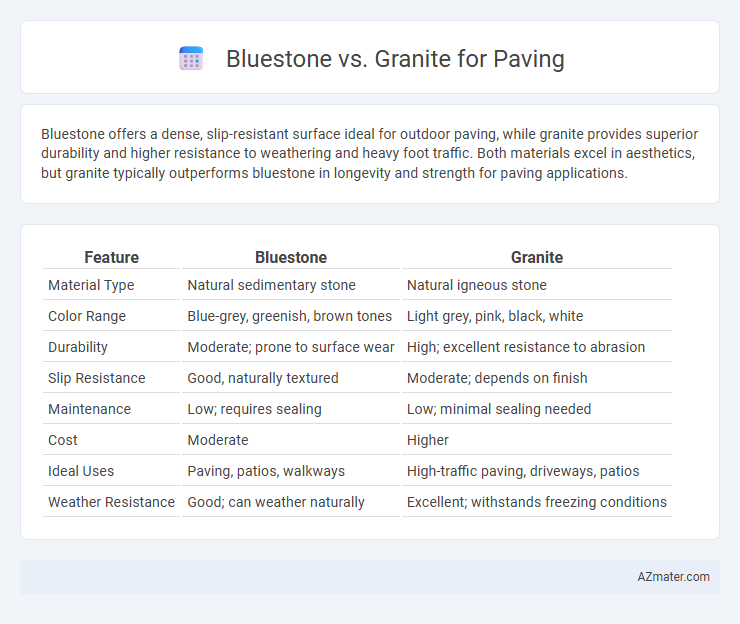Bluestone offers a dense, slip-resistant surface ideal for outdoor paving, while granite provides superior durability and higher resistance to weathering and heavy foot traffic. Both materials excel in aesthetics, but granite typically outperforms bluestone in longevity and strength for paving applications.
Table of Comparison
| Feature | Bluestone | Granite |
|---|---|---|
| Material Type | Natural sedimentary stone | Natural igneous stone |
| Color Range | Blue-grey, greenish, brown tones | Light grey, pink, black, white |
| Durability | Moderate; prone to surface wear | High; excellent resistance to abrasion |
| Slip Resistance | Good, naturally textured | Moderate; depends on finish |
| Maintenance | Low; requires sealing | Low; minimal sealing needed |
| Cost | Moderate | Higher |
| Ideal Uses | Paving, patios, walkways | High-traffic paving, driveways, patios |
| Weather Resistance | Good; can weather naturally | Excellent; withstands freezing conditions |
Introduction to Bluestone and Granite Paving
Bluestone and granite are popular choices for paving due to their durability and aesthetic appeal. Bluestone, a dense sedimentary rock with a smooth, matte finish, offers a natural blue-gray color that enhances outdoor spaces with a rustic charm. Granite, an igneous rock known for its hardness and speckled appearance, provides a wide range of colors and superior resistance to wear and weather conditions, making it ideal for high-traffic areas.
Key Characteristics of Bluestone
Bluestone is a dense, fine-grained sandstone renowned for its natural cleft surface that offers excellent slip resistance, making it ideal for outdoor paving. It typically features a blue-gray tone with subtle variations, enhancing aesthetic appeal while providing durability against weathering and heavy foot traffic. Its ability to withstand harsh climates and low porosity makes bluestone a preferred choice for long-lasting, low-maintenance pavers.
Key Characteristics of Granite
Granite is a dense, durable natural stone with high resistance to scratching, staining, and weathering, making it ideal for high-traffic paving areas. Its coarse-grained texture and wide range of colors, from light gray to black, offer aesthetic versatility and slip resistance. Granite's low porosity ensures minimal water absorption, reducing the risk of cracking in freeze-thaw conditions.
Durability Comparison: Bluestone vs Granite
Bluestone and granite both offer exceptional durability for paving applications, but granite typically outperforms bluestone in hardness and resistance to wear, making it ideal for high-traffic areas. Bluestone, composed primarily of sandstone, provides moderate durability with good resistance to frost and weathering but is more prone to chipping or scratching over time compared to granite. The Mohs hardness scale rates granite at around 6-7, whereas bluestone falls between 3-5, indicating granite's superior long-term performance and low maintenance requirements in paving projects.
Aesthetic Appeal and Design Options
Bluestone offers a unique, natural texture with hues ranging from blue-gray to green, creating a soft, elegant look ideal for traditional and rustic paving designs. Granite provides a highly durable surface with a polished finish and a broader color palette, including speckled patterns that enhance modern, sleek landscapes. Both materials allow versatile design options, but granite's strength supports intricate patterns and heavy traffic areas, while bluestone excels in creating timeless, organic aesthetics.
Cost Analysis: Bluestone vs Granite
Bluestone typically costs between $15 to $30 per square foot, making it a more affordable option compared to granite, which ranges from $25 to $60 per square foot for paving. Installation expenses for both materials vary based on thickness, site preparation, and labor complexity, with granite often requiring higher costs due to its density and cutting challenges. Considering long-term maintenance, granite's durability may reduce replacement costs, while bluestone offers lower upfront investment with moderate upkeep.
Installation Process and Maintenance Requirements
Bluestone paving requires precise cutting and leveling during installation to ensure a smooth surface, often involving mortar for stability, while granite paving hinges on heavy-duty cutting equipment and dry-laid methods for durability. Bluestone tends to demand moderate maintenance, including periodic sealing to prevent water absorption and staining, whereas granite boasts superior resilience with minimal maintenance, primarily occasional cleaning to preserve its polished finish. Choosing between the two depends on balancing Bluestone's aesthetic versatility and moderate upkeep against granite's hardness and low-maintenance advantages for long-term paving solutions.
Weather Resistance and Longevity
Bluestone offers exceptional weather resistance, maintaining its structural integrity and color even under harsh freeze-thaw cycles, making it ideal for colder climates. Granite is known for its superior durability and longevity, resisting wear from heavy foot traffic and extreme weather conditions, including intense heat and moisture. Both materials provide long-lasting paving solutions, but granite typically outperforms bluestone in overall hardness and lifespan.
Eco-Friendliness and Sourcing
Bluestone and granite differ significantly in eco-friendliness and sourcing, with bluestone often sourced locally in the northeastern United States, reducing transportation emissions, while granite is typically quarried globally, increasing its carbon footprint. Bluestone's natural sedimentary composition allows for easier extraction with less environmental disruption compared to granite's harder, igneous formation requiring more intensive quarrying processes. Both materials are durable, but bluestone's shorter supply chain and lower energy extraction contribute to a more sustainable choice for paving projects focused on minimizing environmental impact.
Which is Better for Your Paving Project?
Bluestone offers a natural, dense composition with excellent durability and slip resistance, making it ideal for high-traffic outdoor paving projects that require longevity and safety. Granite's hardness and minimal porosity provide superior resistance to weathering and heavy loads, ensuring a lasting surface with minimal maintenance. Choosing between bluestone and granite depends on project-specific factors such as climate, load requirements, and aesthetic preferences, with granite favored for structural strength and bluestone preferred for slip resistance and texture.

Infographic: Bluestone vs Granite for Paving
 azmater.com
azmater.com